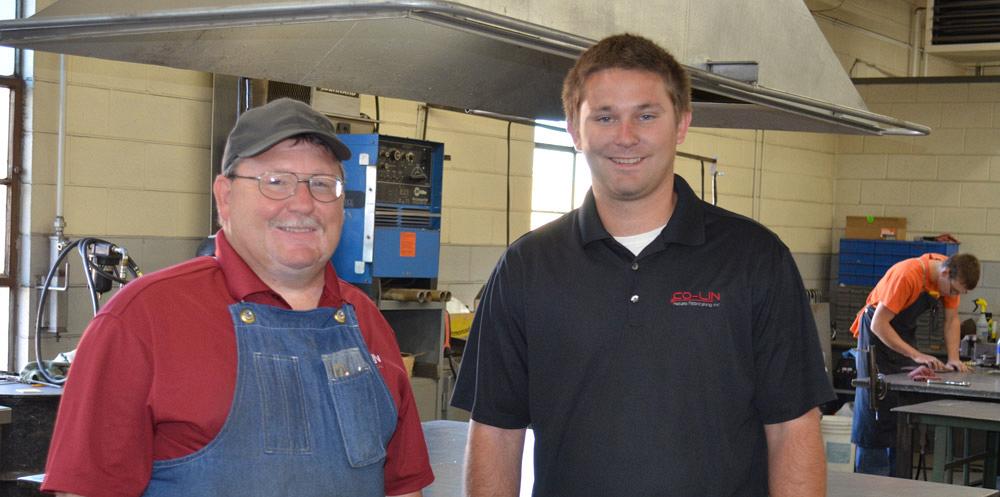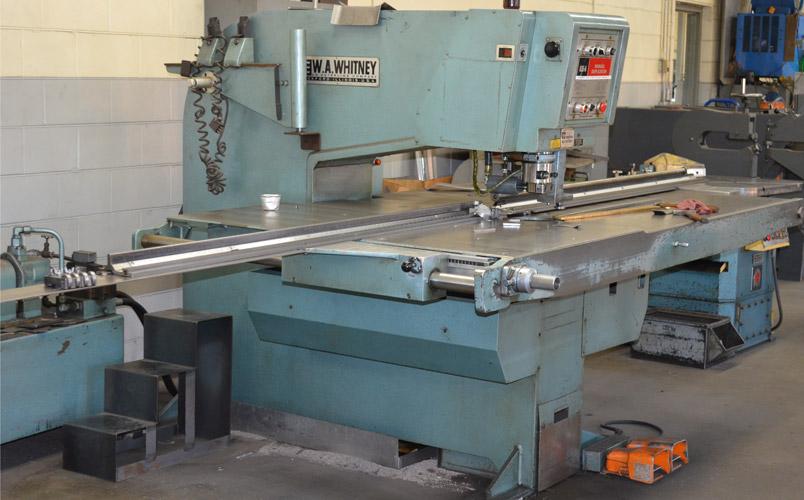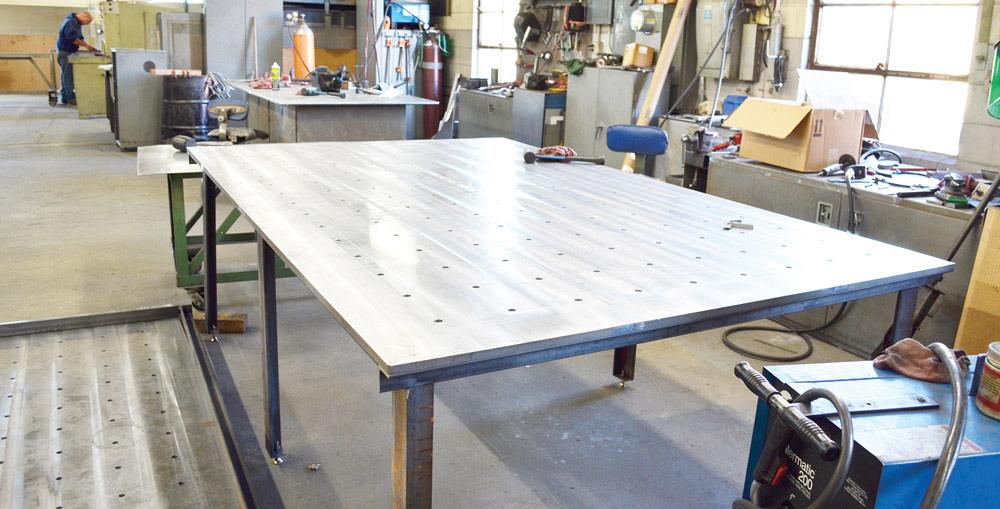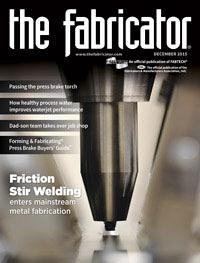Editor-in-Chief
- FMA
- The Fabricator
- FABTECH
- Canadian Metalworking
Categories
- Additive Manufacturing
- Aluminum Welding
- Arc Welding
- Assembly and Joining
- Automation and Robotics
- Bending and Forming
- Consumables
- Cutting and Weld Prep
- Electric Vehicles
- En Español
- Finishing
- Hydroforming
- Laser Cutting
- Laser Welding
- Machining
- Manufacturing Software
- Materials Handling
- Metals/Materials
- Oxyfuel Cutting
- Plasma Cutting
- Power Tools
- Punching and Other Holemaking
- Roll Forming
- Safety
- Sawing
- Shearing
- Shop Management
- Testing and Measuring
- Tube and Pipe Fabrication
- Tube and Pipe Production
- Waterjet Cutting
Industry Directory
Webcasts
Podcasts
FAB 40
Advertise
Subscribe
Account Login
Search
A job shop reborn
A son returns to a metal fabricating shop and joins forces with his dad to relaunch the business
- By Dan Davis
- December 3, 2015
- Article
- Shop Management

Figure 1
Michael Hedlund (left) went to work for Co-Lin Metals Fabricating in June 1980. On another June day in 2015, Hedlund went to work not as an employee, but as co-owner with his son Stephen (right).
Michael Hedlund started work at Co-Lin in 1977 as a 15-year-old summer employee. The owner of the shop lived next door to his parents and asked Michael if he wanted a summer job at the grand pay scale of $3 an hour. He’s been there ever since.
Stephen Hedlund, Michael’s son, started work at Co-Lin in 2006 as a 14-year-old summer employee. His initial tasks were to clean the machines and sweep the floors for a robust $10 per hour. Stephen worked at the shop in subsequent summers, graduating to actually running some of the fabricating machines, but later went on to college and gained valuable industry experience at another nearby fabricator.
The Hedlunds reunited this summer as Co-Lin’s new owners (see Figure 1). They knew the metal fabricating business, but they also knew that their new metal fabricating business had to change.
The Dad’s On-the-Job Education
Michael went from being a summer worker to a full-time employee during his senior year in high school in 1980. That year he attended classes until noon and then went to work at Co-Lin. When he graduated, he asked if he could work there full-time.
“It was a job, and I was glad I had one,” Michael said. “I liked doing it because I was doing something different every day. I learned a lot fast.”
As with any metal fabricating operation, Michael has seen plenty of projects come through the door. Custom fixtures for large aerospace parts manufacturers, industrial cabinets of all shapes and sizes (see Figure 2), custom machinery for specialty manufacturing applications, and gas tanks for classic cars are just a few examples of the work Co-Lin did in the past and continues to do today.
“For as long as I’ve been here, there is something new that happens every day that makes you go, ‘Man, I didn’t think of that!’ he said. “After 35 years, you’d think you know everything.”
Co-Lin never advertised during Michael’s years there. Nearby OEMs and machine shops knew of the fabricator’s reputation, and business continually showed up at the front door. At least, that was the case until the Great Recession.
At that time Michael said he started seeing the work slow a bit, and for the jobs the shop did get, the job routers displayed the old familiar customers. New work was not materializing at the pace it was prior to 2009.
Michael continued to work at his craft, but he knew that the company’s future was questionable. Would it be able to survive doing what it had always done?
The Son’s On-the-Job Training
Following in his dad’s footsteps—somewhat—Stephen went to class for part of the day during his senior year and then went to work at Co-Lin for the rest of the day.
Timing plays a very important role in so many tales, and Stephen’s was no different. Upon graduation in June 2009, Stephen was ready for full-time work, but the manufacturing downturn at the time made that difficult. That’s when he decided to attend the University of Wisconsin at Platteville and pursue a major in manufacturing technology management. That’s where he got his first taste of 3-D modeling. He also worked summers at Co-Lin and other nearby manufacturing companies, where he learned the craft in a way that can’t be replicated in a classroom, such as welding in 100-degree heat.
Upon college graduation in December 2014, he went to work for a Rockford, Ill., metal fabricator for which he had been an intern from January to August in 2013. The fabricator was only a few blocks from Co-Lin.
“That’s where I learned all the real-world stuff, like what’s a flat pattern that you send to a laser cutting machine, designing in 3-D, and interacting with a customer,” Stephen said. “I did all of the quotes there for a while. I was in charge of some pretty big stuff.”
Stephen was taking advantage of an opportunity. His employer was in transition as the fab shop had experienced some turnover in its programming department. Stephen became the go-to person for machine programming, part design, and training new engineers—just three months after graduating from college.
“That’s where I learned how to think on my feet and to do something like this,” he said. “That was my biggest turning point.”
Michael wasn’t surprised when he heard about Stephen’s tenure at the other metal fabricating company. He had noticed that his son was quite capable of leading a business. It probably didn’t hurt that Stephen actually wrote a paper about wanting to run a fabricating shop for a scholarship after high school graduation.
“I knew he wanted to have his own business because he’s always been independent, since he was a baby,” Michael said. “I knew that it would be in some kind of business. I didn’t know it would be this.”
Time to Buy a Business
On Jan. 5, 2015, Michael went to work at Co-Lin and noticed that the owner’s son wasn’t at work. When he asked where the young man was, the owner replied that he had quit and wasn’t coming back. That got Michael to thinking: If the current owner wasn’t interested in changing business operations to grow the company, and the son wasn’t interested in taking over for the father’s business, maybe this was an opportunity for him and Stephen.
That night Michael went home and had a three-hour chat with his son. By the end of the evening, they had decided to pursue business ownership.

Figure 3
This not-yet-completed pressure washer cabinet (left) is a good example of life before and after at Co-Lin Metals Fabricating. The original prints for this cabinet dated back to the 1990s. Some of the original dimensions weren’t detailed on those prints, and Michael Hedlund wasn’t familiar with the cabinets because he didn’t work on the fabrications when Co-Lin did the original work. Stephen Hedlund took pictures of the original cabinets and began modeling them in 3-D. After making some adjustments, such as how to fabricate the movable table inside the pressure washer cabinet (above), Stephen saved the plans in a digital file. The next time it needs to be built, the company can call up the plans and get to work right away.
“So I came into work the next morning and about 10 minutes after arriving, I went to see my boss and said, ‘I’ve got something to tell you. Stephen and I want to buy the place,’” Michael recounted. “And he said, ‘OK. Now what do we do?’
“I don’t know, but I’ll find someone who can tell us,” Michael said.
That led him to the local Small Business Development Center (SBDC) at Rock Valley College in Rockford, Ill. Brian McIntyre, the program director, actually grew up on the same street with both parties.
“It’s good when the buyer and the seller want to work together,” McIntyre said. “What I told Mike and the seller at the beginning is this: ‘I will help you put together a deal and get the thing financed. Here is what I am not going to do: I’m not going to decide what the price is. I’m neutral. You guys figure out the price and we’ll get the deal done.’”
The parties came to a price, which the Hedlunds declined to reveal, and the deal came together quickly thereafter. McIntyre said the father and son brought together different skills and talents that made the financing of the purchase deal easy to secure.
“Mike has spent more than 30 years there, so he had insight about the business, and he had an extreme amount of technical knowledge. Steve worked there part-time, so he understood what it took. He also has an education in that type of business, and he was singularly determined and focused to be a small-business owner,” McIntyre said. “All of those things combined made it a lot easier.”
The Not-So-New Bosses
Stephen, the company’s president, and Michael, vice president, assumed ownership in the beginning of summer 2015. The transition has been relatively smooth because everyone already knew all the parties involved and what was going to happen.
“They all knew we were buying it, so it’s not like I walked in on June 5 and said, ‘Guess what?’” Michael said. “We all kind of had the practice run before it became real.
“I started to implement some things out there even before we took over, such as the way we do certain jobs. I wanted to do it on the other guy’s watch to see if it would work.”
The initial caution wasn’t necessary. The seven full-time fabricators and one part-time front-office administrator went to work as they always did. The Hedlunds had the 8,500-sq.-ft. shop running smoothly, even right after the ownership transfer.

Figure 4
Punching out blanks on Co-Lin’s older punch presses, on which the operator has to hand-crank the punch into position and then engage the punch with a foot pedal, simply can’t compete with having them laser-cut by another company.
Some of the ideas Michael implemented before the official transition paid off, he said. For example, instead of having a couple of fabricators work on one gas tank at a time until it was completed, Michael directed one fabricator to form the metal parts for four or five gas tanks at a time and then deliver them to the welder for the finishing work. At one time Co-Lin was 10 weeks behind on gas tank orders; with the change in work flow, however, that backlog was eliminated by the time the Hedlunds stepped into the building as owners.
“Everyone out there can run every machine, can weld, and put stuff together,” Stephen said. “We can hand most of the guys any kind of print and let them have at it. That’s rare these days.”
The Modernization Effort
While the Hedlunds didn’t have to worry much about the shop floor skills, the front office was another matter. Along with a printer, Stephen knew he wanted to introduce the shop to the world of 3-D modeling. Trying to visualize how something might go together, sometimes without the benefit of blueprints, was eating up too much time.
Stephen said that he could spend two to three days looking at something as simple as a test stand for a local aerospace systems manufacturer and not totally visualize what was needed to make a complete fabrication. What is inside a small, hard-to-access area? How does a particular corner overlap? An older job might involve going over as many as 120 prints.
That’s not the case now. Roughly six months into the new adventure, all the recurring jobs are based on 3-D models (see Figure 3). Michael doesn’t have to wait for his old boss to take the engineering notes and formally draw them for the shop floor to follow, a process that could take days. Now Stephen can call up the job, print out the layout, and walk it to the back of the shop for quick consultation with the fabricator assigned to the project.
The Hedlunds have made some other significant changes as well:
- Co-Lin has all of its blanks laser-cut by the metal fabricator Stephen interned with. It’s simply a lot faster than the company’s old punch presses (see Figure 4). Co-Lin can turn around parts a lot faster, and get paid sooner, rather than having to wait for blanks to be made in-house.
- The shop floor has a new jig-friendly table, where fixtures can be set up quickly (see Figure 5). This accommodates quick tack welding of large fabrications that can be moved over to a large work table for final welding. Previously the fabricators spent several minutes trying to assemble a stick frame that would act as a fixture. The new welding table makes moving from one job to another quick and simple.
- The gas tank fabricators used to spend plenty of time grinding welds to remove the heat tint around the joint. The Hedlunds invested in a passivation machine to remove the heat tint and help boost corrosion resistance around the weld. The fabricators are no longer grinding off the weld as they remove the heat tint. Michael added that the customers like the look of having the weld remain on the gas tanks.
“This is what I know,” Michael said as he looked around the front office, “these four walls I’ve been coming to forever. I don’t know what other people do.”
Stephen has a good idea, however, and he likes where the company is. Each employee is consistently working about 40 to 45 hours per week, instead of 50 to 55 hours per week, which was the case in the middle of summer, yet they are producing the same amount of work. From a sales perspective, Stephen said that Co-Lin is 20 percent ahead of his early projections.
“I got lucky. I can go out there [on the shop floor] and do just about everything, too, which is nice. I got lucky seeing that as a kid. Not many people learn to TIG weld when they’re 15 or run a press brake,” Stephen said. “And then for me to be able to go to a bigger company and learn from somebody else how to quote and all of that is lucky too.
“He never did any of the office stuff,” Stephen jokingly said of his dad.

Figure 5
Stephen Hedlund had a custom welding table made so that fabricators can construct fixtures quickly and change over to the next job in a few minutes.
“I didn’t know anything. I still don’t,” Michael replied. “Just keep telling me we’re making money.”
That’s the plan. Stephen said that he wants to invest in an ERP system to help with scheduling of jobs and general data organization. He also one day would like to own a laser cutting machine. In the meantime, he’ll keep looking out for new customers and pursuing more logical job flow for the shop floor.
In short, Co-Lin is becoming a 21st century metal fabricator.
Co-Lin Metals Fabricating Inc., 5075 26th Ave., Rockford, IL 61109, 815-399-5311, www.co-linmetals.com
About the Author

Dan Davis
2135 Point Blvd.
Elgin, IL 60123
815-227-8281
Dan Davis is editor-in-chief of The Fabricator, the industry's most widely circulated metal fabricating magazine, and its sister publications, The Tube & Pipe Journal and The Welder. He has been with the publications since April 2002.
subscribe now

The Fabricator is North America's leading magazine for the metal forming and fabricating industry. The magazine delivers the news, technical articles, and case histories that enable fabricators to do their jobs more efficiently. The Fabricator has served the industry since 1970.
start your free subscription- Stay connected from anywhere

Easily access valuable industry resources now with full access to the digital edition of The Fabricator.

Easily access valuable industry resources now with full access to the digital edition of The Welder.

Easily access valuable industry resources now with full access to the digital edition of The Tube and Pipe Journal.
- Podcasting
- Podcast:
- The Fabricator Podcast
- Published:
- 04/16/2024
- Running Time:
- 63:29
In this episode of The Fabricator Podcast, Caleb Chamberlain, co-founder and CEO of OSH Cut, discusses his company’s...
- Industry Events
16th Annual Safety Conference
- April 30 - May 1, 2024
- Elgin,
Pipe and Tube Conference
- May 21 - 22, 2024
- Omaha, NE
World-Class Roll Forming Workshop
- June 5 - 6, 2024
- Louisville, KY
Advanced Laser Application Workshop
- June 25 - 27, 2024
- Novi, MI
































